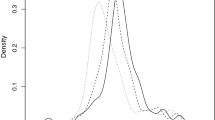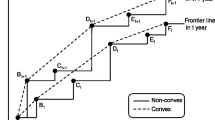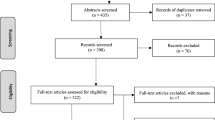Abstract
This paper analyzes the impact of banking reforms on efficiency and total factor productivity (TFP) change in Chinese banking industry. Using an input distance function, we find that joint-equity banks are more efficient than wholly state-owned banks (WSOBs). Furthermore, both WSOBs and joint-equity banks are found to be operating slightly below their optimal size, suggesting potential advantages in expansion of their businesses. Overall, TFP growth was 4.4% per annum for the sample period 1993–2002. Joint-equity banks experienced much higher growth in TFP (5.5% per annum) compared to the WSOBs (1.4% per annum).
Similar content being viewed by others
References
Almanac of Chinese Banking and Finance, various issues, 1993–2004.
Alchian A.A. (1965). Some economics of property rights. Il Politico, 30: 816–829
Atkinson S.E., Cornwell C. (1998). Estimating radial measures of productivity growth: frontier vs non-frontier approaches. Journal of Productivity Analysis, 10, 35–46
Battese G.E., Coelli T.J. (1992). Frontier production functions, technical efficiency and panel data: with application to paddy farmers in India. Journal of Productivity Analysis, 31–32, 153–169
Battese G.E., Coelli T.J. (1995). A model for technical inefficiency effects in a stochastic frontier production function for panel data. Empirical Economics, 20, 325–332
Bauer P.W., Berger A.N., Humphrey D.B. (1993). Efficiency and productivity growth in US banking. In: Fried H.O., Lovell C.A.K., Schmidt S.S. (eds). The measurement of productive efficiency: techniques and applications. Oxford, Oxford University Press, pp. 386–413
Berger A.N., Humphrey D.B. (1997). Efficiency of financial institutions: International survey and directions for future research. European Journal of Operational Research, 98, 175–212
Berger A.N., Mester L.J. (1997). Inside the black ox: What explains differences in the efficiency of financial institutions. Journal of Banking and Finance, 21, 895–947
Berger A.N., Mester L.J. (2003). Explaining the dramatic changes in performance of US banks: Technological change, deregulation, and dynamic changes in competition. Journal of Financial Intermediation, 12, 57–95
Bhattacharyya A., Lovell C.A.K., Sahay P. (1997). The impact of liberalization on the productive efficiency of Indian commercial banks. European Journal of Operational Research, 98, 332–345
Bhattasali D. (2002). Accelerating financial market restructuring in China. World Bank, mimeo
Bonin J.P., Hasan I., Wachtel P. (2004). Bank performance, efficiency and ownership in transition countries. Journal of Banking and Finance, 29, 31–53
Bonin J.P., Huang Y. (2001). Dealing with the bad loans of the Chinese banks. Journal of Asian Economics, 12, 197–214
Clark A.J., Thomas S.F. (2002). X-efficiency in banking: Looking beyond the balance sheet. Journal of Money, Credit, and Banking, 34(4): 987–1013
Cuesta R.A., Orea L. (2002). Mergers and technical efficiency in Spanish savings banks: A stochastic distance function approach. Journal of Banking and Finance, 26(12): 2231–2247
DaCosta M., Foo J. (2002). China’s financial system: Two decades of gradual reforms. Managerial Finance, 28(10):3–18
de Alessi L. (1980). The economics of property rights: A review of the evidence. In: Richard O.Z. (eds). Research in law and economics: A research annual, Vol .2. Greenwich, CT, Jai Press, pp. 1–47
DeYoung R. (1997). Measuring bank cost efficiency: Don’t count on accounting ratios. Financial Practice and Education, 7(1): 20–31
Estrin S., Perotin V. (1991). Does ownership always matter?. International Journal of Industrial Organization, 9(1): 55–72
Färe R., Primont D. (1995). Multi-output production and duality: Theory and applications. New York, Kulwer Academic Publishers
Fries S., Taci A. (2005). Cost efficiency of banks in transition: Evidence from 289 banks in 15 post-communist countries. Journal of Banking and Finance, 29, 55–81
Gordon M.J. (2003). Is China’s financial system threatened by its policy loans debt?. Journal of Asian Economics, 14, 181–188
Hasan I., Marton K. (2003). Development and efficiency of the banking sector in a transitional economy: Hungarian experience. Journal of Banking and Finance, 27, 2249–2271
Hu F. (2000). NPL resolution and bank restructuring in China. In: Watanabe M. (eds). IDE spot survey: China’s non-performing loan problem. Japan, Institute of Developing Economies, pp. 39–48
Hughes J.P., Mester L.J. (1993). A quality and risk-adjusted cost function for banks: Evidence on the "too-big-to-fail" doctrine. Journal of Productivity Analysis, 4(3): 293–315
Hughes J.P., Mester L.J. (1998). Bank capitalization and cost: Evidence of scale economies in risk management and signaling. Review of Economics and Statistics, 80(2): 314–325
Hughes J.P., Lange W., Mester L., Moon C. (1999). The dollars and sense of bank consolidation. Journal of Banking and Finance, 23, 291–324
Humphrey D.B., Pulley L.B. (1997). Banks’ responses to deregulation: Profits, technology, and efficiency. Journal of Money, Credit and Banking, 29, 73–93
Hunter W.C., Timme S.G. (1986). Technical change, organizational form, and the structure of bank production. Journal of Money, Credit, and Banking, 18(2): 152–166
Jondrow J., Lovell C.A.K., Materov I.S., Schmidt P. (1982). On the estimation of technical inefficiency in the stochastic frontier production function model. Journal of Econometrics, 19 (2/3): 233–248
Karagiannis G., Midmore P., Tzouvelekas V. (2004). Parametric decomposition of output growth using a stochastic input distance function. American Journal of Agricultural Economics 86(4): 1044–1057
Kraft E., Tirtiroglu D. (1998). Bank efficiency in Croatia: A stochastic frontier analysis. Journal of Comparative Economics, 26, 282–300
Kumbhakar S.C., Heshmati A., Hjalmarsson L. (1997). Temporal patterns of technical efficiency: Results from competing models. International Journal of Industrial Organization, 15, 597–616
Kumbhakar S.C., Lozano-Vivas A., Lovell C.A.K., Hasan I. (2001). The effects of deregulation on the performance of financial institutions: The case of Spanish savings banks. Journal of Money, Credit, and Banking, 33(1): 101–120
Kumbhakar S.C., Lovell C.A.K. (2000). Stochastic frontier analysis. New York, Cambridge University Press
Kumbhakar S.C., Ghosh S., McGuckin J.T. (1991). A generalized production frontier approach for estimating determinants of inefficiency in U.S. dairy farms. Journal of Business and Economic Statistics, 9(3): 279–286
Kumbhakar S.C., Sarkar S. (2003). Deregulation, ownership, and productivity growth in the banking industry: Evidence from India. Journal of Money, Credit, and Banking, 35(3): 403–424
Laeven, L. (1999). The efficiency of the Thai banking system, Unpublished manuscript, World Bank.
Lardy, N. R. (1999). The challenge of bank restructuring in China. Strengthening the banking system in China: Issues and experience, BIS Policy Papers, No. 7, 17–39.
Leightner J.E., Lovell C.A.K. (1998). The impact of financial liberalization on the performance of Thai bank. Journal of Economics and Business, 50, 115–131
Levy B. (1987). A theory of public enterprise behavior. Journal of Economic Behavior & Organization, 8(1): 75–96
Leung M.K., Rigby D., Young T. (2003a). Entry of foreign banks in the People’s Republic of China: A survival analysis. Applied Economics 35, 21–31
Leung M.K., Young T., Rigby D. (2003b). Explaining the profitability of foreign banks in Shanghai. Managerial and Decision Economics, 24, 15–24
Li S.L., Liu F., Liu S., Whitmore G.A. (2001). Comparative performance of Chinese commercial banks: Analysis, findings and policy implications. Review of Quantitative Finance and Accounting, 16, 149–170
Marsh, T. L., Featherstone, A. M., & Garrett, T. A. (2003). Input inefficiency in commercial banks: A normalized quadratic input distance approach. Federal Reserve Bank of St. Louis, Working Paper 036A.
Mendes V., Reblo J. (1999). Productive efficiency, technological change and productivity in Portuguese banking. Applied Financial Economics, 9, 513–521
Mo Y. K. (1999). A review of recent banking reform in China. Strengthening the Banking System in China: Issues and Experience, BIS Policy Papers, No. 7, 90–109.
Morrison Paul C.J., Johnston W.E., Frengley G.A.G. (2000). Efficiency in New Zealand sheep and beef farming: The impact of regulatory reform. Review of Economics and Statistics, 82, 325–337
Nikiel E.M., Opiela T.P. (2002). Customer type and bank efficiency in Poland: Implications for emerging banking market. Contemporary Economic Policy, 20, 255–271
Park A., Sehrt K. (2001). Tests of financial intermediation and banking reform in China. Journal of Comparative Economics, 29(4): 608–644
Sarkar J., Sarkar S., Bhaumik S.K. (1998). Does ownership always matter? Evidence from the Indian banking industry. Journal of Comparative Economics, 26, 262–281
Sealey C.W. Jr., Lindley J.T. (1977). Inputs, outputs, and a theory of production and cost at depository financial institutions. Journal of Finance, 32(4): 1251–1266
Shephard R.W. (1953). Cost and production functions. Princeton, Princeton University Press
Shirai, S. (2002). Banking sector reforms in India and China: Does India’s experience offer lessons for China’s future reform agenda? JBICI Discussion Paper, No. 2.
Wang H.-J., Schmidt P. (2002). One-step and two-step estimation of the effects of exogenous variables on technical efficiency levels. Journal of Productivity Analysis, 18, 129–144
Wheelock D.C., Wilson P.W. (1999). Technical progress, inefficiency, and productivity change in U.S. Banking, 1984–1993. Journal of Money, Credit, and Banking, 31(2): 212–234
Author information
Authors and Affiliations
Corresponding author
Rights and permissions
About this article
Cite this article
Kumbhakar, S.C., Wang, D. Economic reforms, efficiency and productivity in Chinese banking. J Regul Econ 32, 105–129 (2007). https://doi.org/10.1007/s11149-007-9028-x
Published:
Issue Date:
DOI: https://doi.org/10.1007/s11149-007-9028-x




